|
Mcdonald Brothers' Sawmill
Sherbrooke Village, Nova Scotia
by Robert W. Frame
 The permanent settlement of Sherbrooke is relatively recent in the history of Nova Scotia. There is no indication of a substantial settlement until the first decade of the nineteenth century, although a French trading post had been established as early as 1655 only to fall prey to English captors a few short years later. The permanent settlement of Sherbrooke is relatively recent in the history of Nova Scotia. There is no indication of a substantial settlement until the first decade of the nineteenth century, although a French trading post had been established as early as 1655 only to fall prey to English captors a few short years later.
 The timber industry was the impetus for permanent settlement and was the mainstay of the economy until very recent times. During the time when water was the only efficient manner of transportation and power, Sherbrooke was ideally situated at the head of the tide on the St. Mary's River. The river is one of the largest in Nova Scotia, and with its tributaries, winds through thousands of acres of highly productive timberland. A system of dams and booms provided a convenient transportation network for logs. Milled into deal, boards, laths and other lumber by water-powered mills at Sherbrooke, the products of the forest were then loaded on schooners at the village for the voyage to the British market. In fact, the lumber industry was so significant to Sherbrooke that Joseph Howe, Nova Scotian journalist and politician, wrote in 1831 that "the Village is a creation of the timber trade". He went on to say that the main occupation of the Village was the building of "two or three small vessels on the stocks, and the rafting, securing and sawing of timber."1 The timber industry was the impetus for permanent settlement and was the mainstay of the economy until very recent times. During the time when water was the only efficient manner of transportation and power, Sherbrooke was ideally situated at the head of the tide on the St. Mary's River. The river is one of the largest in Nova Scotia, and with its tributaries, winds through thousands of acres of highly productive timberland. A system of dams and booms provided a convenient transportation network for logs. Milled into deal, boards, laths and other lumber by water-powered mills at Sherbrooke, the products of the forest were then loaded on schooners at the village for the voyage to the British market. In fact, the lumber industry was so significant to Sherbrooke that Joseph Howe, Nova Scotian journalist and politician, wrote in 1831 that "the Village is a creation of the timber trade". He went on to say that the main occupation of the Village was the building of "two or three small vessels on the stocks, and the rafting, securing and sawing of timber."1
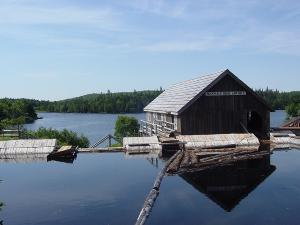
Mill Pond and Sawmill
 The first mill in the Sherbrooke area is thought to have been erected about 1809 by James Fisher who came from Truro in 1805. In 1814 a sawmill and grist mill was set up by David ArchibaldIII, also from Truro, at the site of present day Sherbrooke. Descendants of this Archibald family still operate a water-powered turbine sawmill about 20 miles from Sherbrooke. By 1817, according to Anthony Lockwood's Brief Description of Nova Scotia, there were two sawmills in Sherbrooke, "as well as a grist mill and about 20 houses."2 The first mill in the Sherbrooke area is thought to have been erected about 1809 by James Fisher who came from Truro in 1805. In 1814 a sawmill and grist mill was set up by David ArchibaldIII, also from Truro, at the site of present day Sherbrooke. Descendants of this Archibald family still operate a water-powered turbine sawmill about 20 miles from Sherbrooke. By 1817, according to Anthony Lockwood's Brief Description of Nova Scotia, there were two sawmills in Sherbrooke, "as well as a grist mill and about 20 houses."2

Lumber Camp
 These early mills probably suited the description of sawmills in Nova Scotia given by Captain Moorsom in 1830: These early mills probably suited the description of sawmills in Nova Scotia given by Captain Moorsom in 1830:
"These sawmills, as well as others I have visited present nothing particular in their construction or machinery, a rough shed usually covers the wheel work, and the saws are the common kind, worked by water-power, on the same principle as a saw pit, except that here the saw maintains its position, while the log is forced by machinery to meet the vertical action of the teeth."3
 These humble beginnings provided the basis for continued prosperity in the sawmill industry. By 1861 there were 1,401 sawmills listed in Nova Scotia.4 These humble beginnings provided the basis for continued prosperity in the sawmill industry. By 1861 there were 1,401 sawmills listed in Nova Scotia.4

Inside Sawmill
 The year 1826 marks a unique development in the sawmill industry in Sherbrooke. In that year, William T. Archibald and Henry Cumminger entered into an agreement to erect a double mill at the southern end of the village in what is now a part of the Sherbrooke Village Restoration area. Essentially, the agreement provided for the relocation of Mr. Archibald's mill from its site in another part of Sherbrooke, the installation of a second set of machinery by Mr. Cumminger and the digging of a canal approximately 850 feet in length, 10 feet in width and from 8 to 15 feet deep from Sherbrooke Lake to the St. Mary's River for supply of power for the water wheels. The year 1826 marks a unique development in the sawmill industry in Sherbrooke. In that year, William T. Archibald and Henry Cumminger entered into an agreement to erect a double mill at the southern end of the village in what is now a part of the Sherbrooke Village Restoration area. Essentially, the agreement provided for the relocation of Mr. Archibald's mill from its site in another part of Sherbrooke, the installation of a second set of machinery by Mr. Cumminger and the digging of a canal approximately 850 feet in length, 10 feet in width and from 8 to 15 feet deep from Sherbrooke Lake to the St. Mary's River for supply of power for the water wheels.
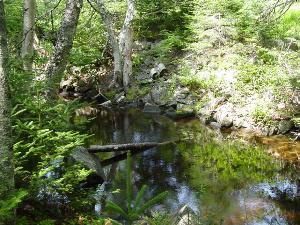
Remnnant of Canal
 The following are excerpts from the lengthy agreements on the undertaking still on file at the St. Mary's Registry of Deeds, Sherbrooke.5 The following are excerpts from the lengthy agreements on the undertaking still on file at the St. Mary's Registry of Deeds, Sherbrooke.5
"(The partners) have at their joint expenses procured a mill race or water course to be cut or opened from the Lake which supplied the said mill stream, to the place which they intend to remove the said sawmill, on which they have also agreed to erect at their joint expense a sawmill with a double set of machinery, and an apparatus to each for hauling up and rolling out logs, and to occupy the said machinery and apparatus after they shall be so completed in severally and whereas the expense of erecting, upholding and rebuilding the necessary dams or embankments for preserving and elevating the water in said Lake or other lakes emptying into the said stream, the flume, mill frame, boom and boom pillar, and of repairing or improving the mill race, should be borne jointly by the said parties..."
 The following gives us some idea of the minimum production expected. The following gives us some idea of the minimum production expected.
"...the said parties have at their joint expense completed the erection of their sawmill on the eastern side of the timber pond with a double set of working gears and other machinery... and are now occupying exclusively their particular set of said machinery, and its appurtenance as by the said agreement was allotted to them respectively..."
 The two mills, although in a common building and sharing common water and timber pond facilities, were completely separate otherwise. In the 1829 agreement the parties agreed: The two mills, although in a common building and sharing common water and timber pond facilities, were completely separate otherwise. In the 1829 agreement the parties agreed:
"to erect at their joint expenses and as soon as either party shall require it, a partition between their respective divisions of said mill through the upper storey, and also a partition from the lower end of the mill to the lower end of the logways to keep their lumber separate when it is run out the mill."
 The parties also agreed to erect "a good and substantial dam" near the head of the mill race to protect race and mill dam from "extraordinary freshets." The parties also agreed to erect "a good and substantial dam" near the head of the mill race to protect race and mill dam from "extraordinary freshets."
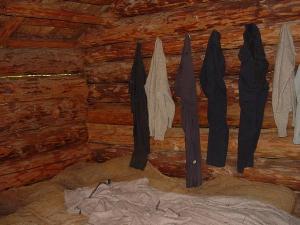
Lumber Camp Sleeping Quarters
 By 1856 ownership of the double mill had been acquired by the McDonald Brothers. Possibly they had difficulty in co-operating in the use of the mills. In any case, they signed an agreement in 1877 which throws some light on the type of machinery in use in the mill at that time. By 1856 ownership of the double mill had been acquired by the McDonald Brothers. Possibly they had difficulty in co-operating in the use of the mills. In any case, they signed an agreement in 1877 which throws some light on the type of machinery in use in the mill at that time.
"It is hereby agreed that should the said David. A. McDonald wish to work the one-fourth part of the Sherbrooke sawmill hereby decided to him the said Alex N. McDonald - also said David A. McDonald is to have the use of the edging and cross cut or trimmer saws during the time he may be working his own part of the up-and-down saw in the same manner and way as the said Donald Kennedy occupied or used them. Also, he, David A. McDonald is entitled to the fourth part of the time of the shingle and lath sawmills should he work them"6.
 The mill was abandoned before 1900 and allowed to fall into ruin. For many years nothing has remained of this once active industry except the hand-dug race which assumed the character of a natural outlet from Sherbrooke Lake. The mill was abandoned before 1900 and allowed to fall into ruin. For many years nothing has remained of this once active industry except the hand-dug race which assumed the character of a natural outlet from Sherbrooke Lake.
 In 1970, with the commencement of work on the restoration of a part of the village of Sherbrooke as a typical 19th century Nova Scotia community, the decision was made to reconstruct a working replica of a water-powered up-and-down sawmill on the site of the McDonald Brothers mill. Although engineering studies were undertaken and plans prepared for a building, machinery and dams, these were abandoned in favour of putting the entire responsibility for the design and fabrication of the plant in the hands of Peter Breen, a local millwright from Monastery, Nova Scotia, with no formal training but with years of experience and keen recollection. In 1970, with the commencement of work on the restoration of a part of the village of Sherbrooke as a typical 19th century Nova Scotia community, the decision was made to reconstruct a working replica of a water-powered up-and-down sawmill on the site of the McDonald Brothers mill. Although engineering studies were undertaken and plans prepared for a building, machinery and dams, these were abandoned in favour of putting the entire responsibility for the design and fabrication of the plant in the hands of Peter Breen, a local millwright from Monastery, Nova Scotia, with no formal training but with years of experience and keen recollection.
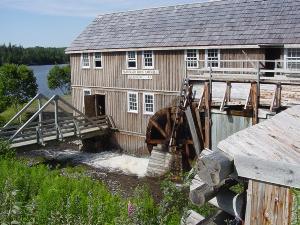
Restored Sawmill
 The first step in the reconstruction of the mill was the building of three dams to control the level and flow of water from Sherbrooke Lake. Sherbrooke Lake is the last in a chain of five lakes which drain into each other. A modern concrete control dam was placed in the head of the single natural outlet from the lake. This dam can be adjusted to increase or decrease the amount of water available in the mill race and pond as conditions dictate. A second small control dam, constructed of peeled hemlock logs in the traditional log crib fashion, was built at the head of the mill race. It allows the level of water in the lake to be maintained at a higher level than that of the race mill pond for storage of water. This dam, when completely shut off, also permits drainage of the mill pond for repairs or cleaning. The first step in the reconstruction of the mill was the building of three dams to control the level and flow of water from Sherbrooke Lake. Sherbrooke Lake is the last in a chain of five lakes which drain into each other. A modern concrete control dam was placed in the head of the single natural outlet from the lake. This dam can be adjusted to increase or decrease the amount of water available in the mill race and pond as conditions dictate. A second small control dam, constructed of peeled hemlock logs in the traditional log crib fashion, was built at the head of the mill race. It allows the level of water in the lake to be maintained at a higher level than that of the race mill pond for storage of water. This dam, when completely shut off, also permits drainage of the mill pond for repairs or cleaning.
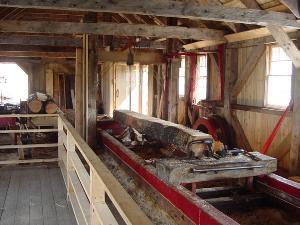
Drop-Blade of Sawmill
 The third and most important dam is a large cribwork dam 20 feet high located at the mill site and forming the small mill pond. Gates are provided to supply water by way of a flume to the water wheel and to allow for drainage of the mill pond. An overflow for excess water is also built in. The third and most important dam is a large cribwork dam 20 feet high located at the mill site and forming the small mill pond. Gates are provided to supply water by way of a flume to the water wheel and to allow for drainage of the mill pond. An overflow for excess water is also built in.
 Completion of the dams allowed for installation of the water-wheel. Built of treated black spruce, the wheel is 12 feet in diameter, 4 feet wide and contains 32 buckets. It is a type known as a high breast wheel. Water from the flume above is directed by an apron onto the wheel just above its axis and is expelled at the bottom of the wheel which turns in a direction opposite in that of an over-shot wheel. It achieves a maximum of 35 revolutions per minute with minimal wastage of water and is vibration-free because of the painstaking care taken in constructing the wheel with proper balance. Completion of the dams allowed for installation of the water-wheel. Built of treated black spruce, the wheel is 12 feet in diameter, 4 feet wide and contains 32 buckets. It is a type known as a high breast wheel. Water from the flume above is directed by an apron onto the wheel just above its axis and is expelled at the bottom of the wheel which turns in a direction opposite in that of an over-shot wheel. It achieves a maximum of 35 revolutions per minute with minimal wastage of water and is vibration-free because of the painstaking care taken in constructing the wheel with proper balance.
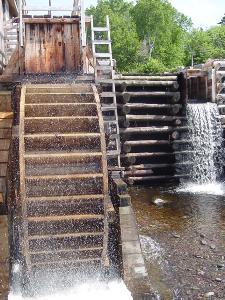
Waterwheel
 The sawmill building is a two-storey structure with hand-hewn post and beam construction and board and batten exterior cladding. The roof is covered with long board shingles with 16-inch-exposure in the weather. The lower storey contains the belt and pulley running gear of the mill, and provision is made for a shingle mill and other woodworking equipment. Upstairs is the log carriage and up-and-down saw with their simple but ingenious mechanisms. The sawmill building is a two-storey structure with hand-hewn post and beam construction and board and batten exterior cladding. The roof is covered with long board shingles with 16-inch-exposure in the weather. The lower storey contains the belt and pulley running gear of the mill, and provision is made for a shingle mill and other woodworking equipment. Upstairs is the log carriage and up-and-down saw with their simple but ingenious mechanisms.
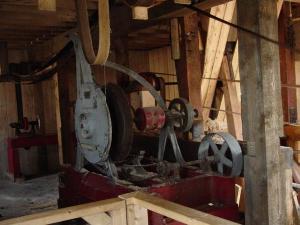
Sawmill Mechanisms
 In simple terms, the up-and-down sawmill is a mechanical application of its hand-powered predecessor, the pit saw. A crank, driven by the waterwheel, moves the saw frame and single saw block in an up-and-down motion cutting into the log on each downward stroke. The up-and-down motion of the saw frame is also used to move the log carriage forward by means of a system of levers and a rachet. Several minutes are required for each cut through the length of an average log. In simple terms, the up-and-down sawmill is a mechanical application of its hand-powered predecessor, the pit saw. A crank, driven by the waterwheel, moves the saw frame and single saw block in an up-and-down motion cutting into the log on each downward stroke. The up-and-down motion of the saw frame is also used to move the log carriage forward by means of a system of levers and a rachet. Several minutes are required for each cut through the length of an average log.
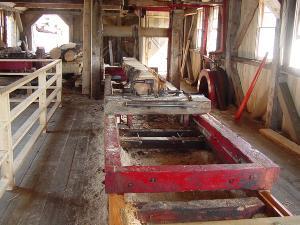
Up and Down Blade of Sawmill
 Blessed by a bountiful supply of water from a chain of five lakes, the reconstructed McDonald Brothers' sawmill is believed to be the only one of its kind capable of full production with water power. Blessed by a bountiful supply of water from a chain of five lakes, the reconstructed McDonald Brothers' sawmill is believed to be the only one of its kind capable of full production with water power.

Sawmill Log-Feed
 The mill is a realistic reconstruction of sawmills which operated across the province on almost every stream, small or large, a century or more ago. Made obsolete with the gradual introduction of the rotary saw and the steam and gasoline engines, they were nevertheless the backbone of the lumbering industry in Nova Scotia until the last quarter of the nineteenth century. The mill is a realistic reconstruction of sawmills which operated across the province on almost every stream, small or large, a century or more ago. Made obsolete with the gradual introduction of the rotary saw and the steam and gasoline engines, they were nevertheless the backbone of the lumbering industry in Nova Scotia until the last quarter of the nineteenth century.
Endnotes
1. Nova Scotian, Halifax, N.S., July 28, 1831, p.238.
2. Lockwood, Anthony, Brief Description of Nova Scotia, London, G. Hayden, 1818, p. 37.
3. Moorsom, capt. William, Letters from Nova Scotia, London, Colburn and Bentley, 1830, p. 296.
4. Martin, J. Lynton, A history of Everyday Things in Nova Scotia, I. Lumbering, In Journal of Education, v. 19, no. 1, 1969, p. 37.
5. The Registry of Deeds has since moved to the town of Guysborough.
6. Excerpts from the agreements originate in Books C, D, E, F, G. and H at the Registry of Deeds, Sherbrooke, Nova Scotia.
[Go Back][Lumber]
|





